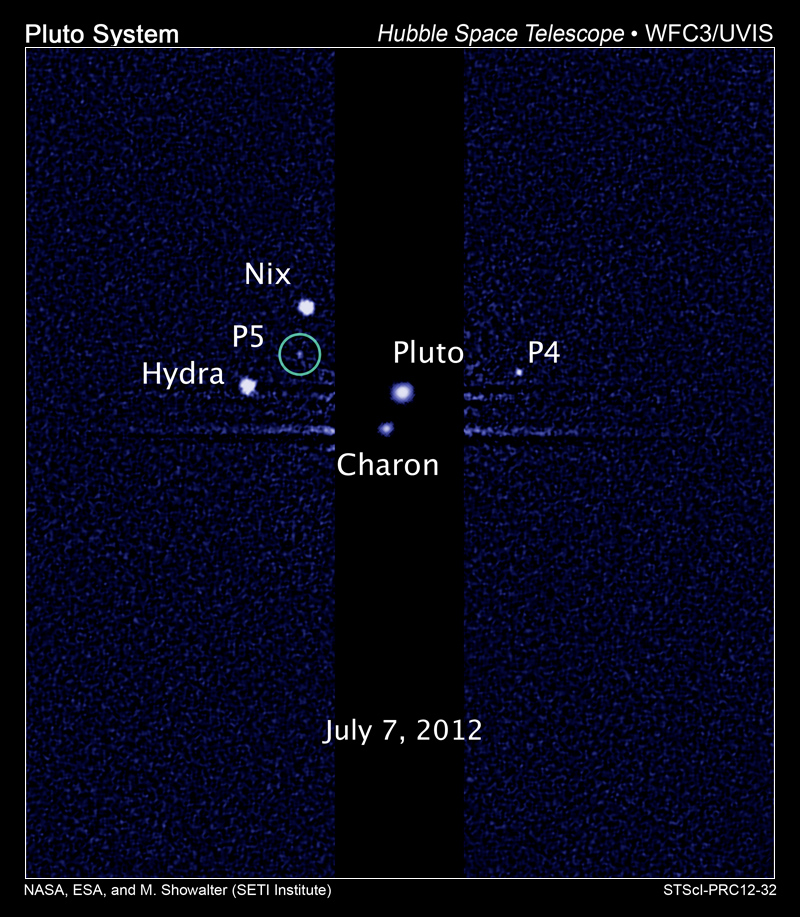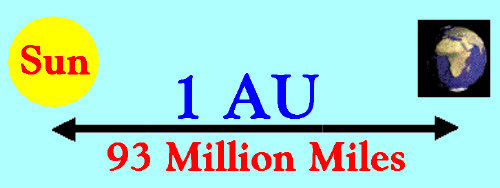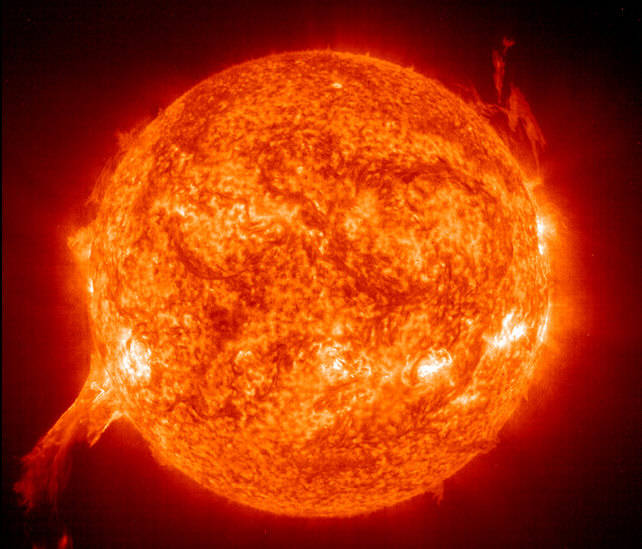The AU value you see below is just a unit of measure scientists use when talking about the Solar system distances. AU stands for Astronomical Unit, and 1 AU is equal to 93,000,000 (million) miles which is the average distance from Earth to the Sun. So instead of saying an object is 279,000,000 million miles from Earth, you can say it is 3 AU from Earth. The Rotation period you see for each planet is the amount of time it takes for that planet to rotate once on it's axis forming 1 Day. You already know the Rotation period for Earth is just a little under 24 hours. These stats will give you an idea of how the Planets compare to each other. You should also read "Basic Gravity" which has a gravity comparison Table at the end of the article that shows the difference in Each Planets Gravity compared to Earth's Gravity. Read "Planet Earth where are You" for more Planet size comparisons and for Earth's location in the Milky Way Galaxy.Click the Underlined Planet name for the picture. The SUN Diameter: 864,400 miles Temperature: surface: 9,926 deg F; core: 27,000,000 deg F Rotation period (in Earth time): at equator: 25.53 days Number of planets: 9 Distance from the Earth (light years): about 8 minutes Distance to nearest star (light years) 4.3 One Light Year = approximately 6 Trillion Miles and is the distance Light travels in one year. The Speed of Light is 186,200 Miles per Second, so it only takes SunLight 8.333 Minutes to reach Earth at the Speed of Light! The Visible Light Glare has been removed in the picture below. A Solar Flare remnant is visible at the lower left of the Sun! Behold the Fire that sustains us! For solar flare details and info on the Birth of Our Sun and Solar System click here:Star Birth
MERCURY Distance from Sun (mean): 36.0 million miles or 0.387 AU. Closest approach to Earth: 57.0 million miles Length of year (in Earth time): 87.97 days Average orbital speed: 107,088 miles per hour Rotation period (in Earth time): 58.65 days. Diameter at equator: 3,032 miles. Number of known moons: 0 VENUS Distance from Sun (mean): 67.0 million miles or 0.72 AU Closest approach to Earth: 25.7 million miles Length of year (in Earth time): 224.7 days Average orbital speed: 78,341 miles per hour Rotation period (in Earth time): -243 days (retrograde) Diameter at equator: 7,521 miles Number of known moons: 0 The (retrograde) you see by the Venus "Rotation period" of -243 days means that Venus Rotates clockwise on its axis forming night and day. Earth and most of the other Planets Rotate counter clockwise forming night and day with the Sun rising in the East and setting in the West. Planet Uranus and Planet Pluto also have (retrograde) Rotation like Planet Venus does. Venus Rotates on its axis so VERY slowly that one day on Venus is as long as 243 days on Earth! So on Planet Venus one Day is longer than one Year! All of the Planets orbit the Sun in a Counter Clockwise direction. EARTHDistance from Sun (mean): 93.0 million miles or 1.00 AU Length of year (in Earth time): 365.25 days Average orbital speed: 66,629 miles per hour Rotation period (in Earth time): 23 hr 56 minutes Diameter at equator: 7,926 miles Number of known moons: 1 MARS
Distance from Sun (mean): 141.4 million miles or 1.52 AU Closest approach to Earth: 34.6 million miles Length of year (in Earth time): 687 days Average orbital speed: 53,979 miles per hour Rotation period (in Earth time): 24 hr 37 minutes Diameter at equator: 4,222 miles Number of known moons: 2 1. Deimos 2. Phobos JUPITER Distance from Sun (mean): 483.3 million miles or 5.2 AU Closest approach to Earth: 390.7 million miles Length of year (in Earth time): 11.86 years Average orbital speed: 29,236 miles per hour Rotation period (in Earth time): 9 hr 56 min Diameter at equator: 88,846 miles Number of known moons: 67 1. Io 2. Europa 3. Ganymede 4. Callisto 5. Amalthea 6. Himalia 7. Elara 8. Pasiphae 9. Sinope 10. Lysithea 11. Carme 12. Ananke 13. Leda 14. Thebe 15. Adrastea 16. Metis 17. Callirrhoe 18. Themisto 19. Megaclite 20. Taygete 21. Chaldene 22. Harpalyke 23. Kalyke 24. Iocaste 25. Erinome 26. Isonoe 27. Praxidike 28. Autonoe 29. Thyone 30. Hermippe 31. Aitne 32. Eurydome 33. Euanthe 34. Euporie 35. Orthosie 36. Sponde 37. Kale 38. Pasithee 39. Hegemone 40. Mneme 41. Aoede 42. Thelxinoe 43. Arche 44. Kallichore 45. Helike 46. Carpo 47. Eukelade 48. Cyllene 49. Kore 50. Herse 51. S/2000 J11 52. S/2003 J2 53. S/2003 J3 54. S/2003 J4 55. S/2003 J5 56. S/2003 J9 57. S/2003 J10 58. S/2003 J12 59. S/2003 J15 60. S/2003 J16 61. S/2003 J18 62. S/2003 J19 63. S/2003 J23 64. S/2010 J 1 65. S/2010 J 2 66. S/2011 J1 67. S/2011 J2 SATURN Distance from Sun (mean): 886.7 million miles or 9.54 AU Closest approach to Earth: 793.7 million miles Length of year (in Earth time): 29.46 years Average orbital speed: 21,637 miles per hour Rotation period (in Earth time): 10 hr 39 min Diameter at equator: 74,898 miles Number of known moons: 62 1. Mimas 2. Enceladus 3. Tethys 4. Dione 5. Rhea 6. Titan 7. Hyperion 8. Iapetus 9. Erriapo 10. Phoebe 11. Janus 12. Epimetheus 13. Helene 14. Telesto 15. Calypso 16. Kiviuq 17. Atlas 18. Prometheus 19. Pandora 20. Pan 21. Ymir 22. Paaliaq 23. Tarvos 24. Ijiraq 25. Suttungr 26. Mundilfari 27. Albiorix 28. Skathi 29. Siarnaq 30. Thrymr 31. Narvi 32. Methone 33. Pallene 34. Polydeuces 35. Daphnis 36. Aegir 37. Bebhionn 38. Bergelmir 39. Bestla 40. Farbauti 41. Fenrir 42. Fornjot 43. Hati 44. Hyrokkin 45. Kari 46. Loge 47. Skoll 48. Surtur 49. Greip 50. Jarnsaxa 51. Tarqeq 52. Anthe 53. Aegaeon 54. S/2004 S7 55. S/2004 S12 56. S/2004 S13 57. S/2004 S17 58. S/2006 S1 59. S/2006 S3 60. S/2007 S2 61. S/2007 S3 62. S/2009 S1
Watch a Video of Enceladus, one of Saturn's small Moons. Enceladus Video URANUS Distance from Sun (mean): 1,784.0 million miles or 19.18 AU Closest approach to Earth: 1,607.0 million miles Length of year (in Earth time): 84.02 years Average orbital speed: 15,290 miles per hour Rotation period (in Earth time): -17 hr 14 minutes (retrograde) Diameter at equator: 31,764 miles Number of known moons: 27 1. Cordelia 2. Ophelia 3. Bianca 4. Cressida 5. Desdemona 6. Juliet 7. Portia 8. Rosalind 9. Mab 10. Belinda 11. Perdita 12. Puck 13. Cupid 14. Miranda 15. Francisco 16. Ariel 17. Umbriel 18. Titania 19. Oberon 20. Caliban 21. Stephano 22. Trinculo 23. Sycorax 24. Margaret 25. Prospero 26. Setebos 27. Ferdinand NEPTUNE Distance from Sun (mean): 2,798.7 million miles or 30.06 AU Closest approach to Earth: 2,680.0 million miles Length of year (in Earth time): 164.8 years Average orbital speed: 12,253 miles per hour Rotation period (in Earth time): 16 hr 6 minutes Diameter at equator: 30,776 miles Number of known moons: 14 1. Naiad 2. Thalassa 3. Despina 4. Nereid 5. Galatea 6. Larissa 7. Proteus 8. Triton 9. S/2002 N1 10. S/2002 N2 11. S/2002 N3 12. S/2002 N4 13. Psamathe 14. S/2004 N1 PLUTO Click for the July 2015 picture! Distance from Sun (mean): 3,674.5 million miles or 39.53 AU Closest approach to Earth: 2,670.0 million miles Length of year (in Earth time): 247.92 years Average orbital speed: 10,623 miles per hour Rotation period (in Earth time): -6 days 9 hours (retrograde) Diameter at equator: 1,430 miles Number of known moons: 5 1. Charon 2. Nix 3. Hydra 4. Kerberos 5. Styx Charon was discovered in 1978. Hubble discovered Nix and Hydra in 2005, Kerberos in 2011, and Styx in 2012. P4 and P5 shown in the picture below were the temporary names for Kerberos and Styx which had not been named when the picture was taken.


The Comparison Table below is from my "Basic Gravity 101" article. Basic Gravity is in easy to understand terms and I hope is a help to parents out there without a lot of Science knowledge. Give it a read from the link below. I hope it helps you with homework and sparks your interest in science. If I use a complex term I will always follow up with a simple example. I want to bring Science knowledge to everyone in easy to understand terminology. If you enjoyed "Basic Gravity" please read "Planet Earth where are You" which explains the Solar System and Earth's location in our Milky Way Galaxy. After a hard day at work you might enjoy some humor, so read "Interstellar Travel" and see if it makes you smile. I hope you enjoy your time here and my new article on Planet Venus is online now so give it a read! I bet you like it.

Read InterStellar Travel
Read The Universe Reality and You
Read Planet Earth where are You?
Read Basic Gravity 101 (easy to understand)
Read Roswell, Aliens, and Mankind!
Read the Asteroid Threat to planet Earth!
Read UFO's the Alien Point of View.
Read The Birth & Death of our Sun.
Read Planet Venus, second from the Sun.

Home Page

